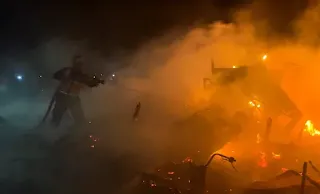The occupation forces burn the tents of displaced people in Khan Yunis / Reuters
Six Palestinians from the same family were killed in an Israeli airstrike that targeted a tent housing displaced persons in the Beit Lahia project in the northern Gaza Strip. This brings the death toll in Gaza as a result of Israeli attacks on Wednesday to 34 Palestinians, in addition to 18 others killed after midnight on Thursday.
Earlier on Wednesday, the Ministry of Health in Gaza announced that the death toll from the Israeli genocide had risen to 51,025, with 116,432 injured since October 7, 2023. The Ministry stated that "the death toll and injuries since March 18, 2025, have reached 1,652 martyrs and 4,391 injured."
500,000 people have been displaced in Gaza since mid-March
The United Nations Office for the Coordination of Humanitarian Affairs (OCHA) announced on Wednesday that approximately 500,000 Palestinians have been displaced from their homes in the Gaza Strip since March 18, due to Israel's resumption of genocide and its reneging on a ceasefire with Hamas.
The office said, according to the UN News website, that hundreds of thousands of Palestinians were displaced repeatedly before the temporary ceasefire on January 19, 2025. It added that "the ongoing hostilities across the Gaza Strip continue to have a devastating impact on civilians, including death, displacement, and the destruction of vital infrastructure."
On Wednesday, Israeli Defense Minister Yisrael Katz acknowledged that hundreds of thousands of Palestinians had been forced to flee their homes, saying that the army would remain in the locations it had occupied in the Gaza Strip as "buffer zones" temporarily or permanently. In a post on the X platform, Katz added, "In contrast to the past, the IDF is not evacuating (leaving) areas that have been cleared and seized."
The Israeli military announced in a statement on Wednesday that, nearly a month after the resumption of the war in Gaza, approximately 30% of the Strip's area had become an "operational security zone," indicating that it was now off-limits to Palestinians, forcing them to flee and subsequently preventing them from accessing it.
Since resuming the genocide on March 18, the army has expanded the so-called security zone centered on the Gaza Strip's borders, as well as the Rafah area, which it has isolated from Khan Yunis through what it calls the "Morag Axis" in the southern Gaza Strip.
Regarding humanitarian access, OCHA noted that Tel Aviv "continues to refuse approval for coordinated missions and today facilitated only two of six planned humanitarian movements coordinated with Israeli authorities." It added that "Israel rejected four other missions, including one to bring fuel from Rafah," without clarifying the reasons for rejecting the remaining movements, or the nature of the missions or the humanitarian aid they carried.
The office stated that its teams visited displacement sites in Khan Younis last week, where "the majority of people are living in overcrowded shelters, with limited access to shelter, food, water, and medicine." It noted that "aid workers reported that tents are no longer available for distribution across the Strip. In the town of Bani Suhaila in Khan Younis, south of the Strip, for example, newly displaced families have received only a few blankets and tarpaulins."
The United Nations reported that "acute malnutrition in the Gaza Strip has worsened, with the number of children receiving supplementary feeding dropping by more than two-thirds in March."
Israel's restrictions on humanitarian access are hampering the ability to supply hospitals with medical supplies, putting the health of more patients at risk, according to the United Nations. Since March 2, the Israeli military has been preventing the entry of essential supplies, including food and water, into the Gaza Strip following its closure of the crossings, causing a humanitarian catastrophe and worsening famine.
In early March, the first phase of a ceasefire and prisoner exchange agreement between Hamas and Israel concluded. The agreement, which went into effect on January 19, 2025, was brokered by Egypt and Qatar and supported by the United States.
While Hamas adhered to the terms of the first phase, Israeli Prime Minister Benjamin Netanyahu, who is wanted by the International Criminal Court, shied away from initiating the second phase in deference to extremists in his ruling coalition, according to Hebrew media.

